Showing Spotlights 481 - 488 of 2784 in category All (newest first):
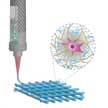 Recent developments in hydrogel chemistries, reinforcement approaches, and crosslinking methods have expanded the applications of 3D bioprinting to pharmaceutics, regenerative medicine, and biomedical devices. A multitude of 3D bioprinting techniques have been developed, but among these different approaches, extrusion-based 3D bioprinting has become a popular technique as it is easy to optimize and all its constituents are economical in price. A recent review elucidates the nuances of 3D bioprinting in a step-by-step guideline format, from its basics to more advanced levels.
Recent developments in hydrogel chemistries, reinforcement approaches, and crosslinking methods have expanded the applications of 3D bioprinting to pharmaceutics, regenerative medicine, and biomedical devices. A multitude of 3D bioprinting techniques have been developed, but among these different approaches, extrusion-based 3D bioprinting has become a popular technique as it is easy to optimize and all its constituents are economical in price. A recent review elucidates the nuances of 3D bioprinting in a step-by-step guideline format, from its basics to more advanced levels.
Apr 10th, 2020
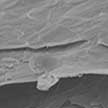 Researchers have developed black phosphorus (BP) functionalized graphene films, resulting in record toughness. The formation of covalent bonding between BP and graphene oxide (GO) nanosheets not only reduces the voids of GO film but also improves the alignment degree of GO nanosheets, resulting in high compactness of the GO film. After further chemical reduction and pi-pi stacking interactions by conjugated AD molecules, the alignment degree of reduced graphene oxide (rGO) nanosheets was further improved, and the voids in lamellar graphene film were also further reduced. The toughness of this graphene film reaches the highest value recorded to date.
Researchers have developed black phosphorus (BP) functionalized graphene films, resulting in record toughness. The formation of covalent bonding between BP and graphene oxide (GO) nanosheets not only reduces the voids of GO film but also improves the alignment degree of GO nanosheets, resulting in high compactness of the GO film. After further chemical reduction and pi-pi stacking interactions by conjugated AD molecules, the alignment degree of reduced graphene oxide (rGO) nanosheets was further improved, and the voids in lamellar graphene film were also further reduced. The toughness of this graphene film reaches the highest value recorded to date.
Apr 9th, 2020
 Nanotechnology offers many benefits that can be leveraged to increase the potency of vaccine formulations. For anticancer vaccination, antigenic material can be collected directly from a patient's resected tumor, formulated into a biomimetic nanoparticle, and then administered back into the patient to promote tumor-specific immunity. For antibacterial vaccination, strain-specific virulence factors or membrane can be immobilized onto nanoparticle substrates, and the resulting complexes can be used to vaccinate patients with an identified risk against the associated pathogen.
Nanotechnology offers many benefits that can be leveraged to increase the potency of vaccine formulations. For anticancer vaccination, antigenic material can be collected directly from a patient's resected tumor, formulated into a biomimetic nanoparticle, and then administered back into the patient to promote tumor-specific immunity. For antibacterial vaccination, strain-specific virulence factors or membrane can be immobilized onto nanoparticle substrates, and the resulting complexes can be used to vaccinate patients with an identified risk against the associated pathogen.
Apr 3rd, 2020
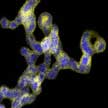 One of the key issues that is holding back widespread applications of noble metal aerogels is a lack of understanding of the underlying structure-performance correlations. Presumably, this is caused by an insufficient understanding of the sol-gel process that limits manipulating versatile parameters, such as ligament sizes, compositions, and spatial element distributions. Recently published findings not only take a big step towards the detailed understanding of reductant chemistry and gelation mechanisms, manipulating the microstructures, and enriching the compositions of NMAs, but also open a new dimension for devising high-performance electrocatalysts by taking advantage of the ligand effects.
One of the key issues that is holding back widespread applications of noble metal aerogels is a lack of understanding of the underlying structure-performance correlations. Presumably, this is caused by an insufficient understanding of the sol-gel process that limits manipulating versatile parameters, such as ligament sizes, compositions, and spatial element distributions. Recently published findings not only take a big step towards the detailed understanding of reductant chemistry and gelation mechanisms, manipulating the microstructures, and enriching the compositions of NMAs, but also open a new dimension for devising high-performance electrocatalysts by taking advantage of the ligand effects.
Mar 30th, 2020
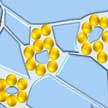 Noble metal aerogels are widely investigated for electrocatalysis applications due to their large specific surface areas and the high catalytic activity of noble metals. However, their fabrication methods are cumbersome. Now though, researchers have developed a freeze-thaw method capable of preparing various hierarchically structured noble metal gels within only one day directly from dilute solutions without extra additives. The method fits various noble metals, and multi-scale structures can be obtained across nanometer and micrometer scales.
Noble metal aerogels are widely investigated for electrocatalysis applications due to their large specific surface areas and the high catalytic activity of noble metals. However, their fabrication methods are cumbersome. Now though, researchers have developed a freeze-thaw method capable of preparing various hierarchically structured noble metal gels within only one day directly from dilute solutions without extra additives. The method fits various noble metals, and multi-scale structures can be obtained across nanometer and micrometer scales.
Mar 26th, 2020
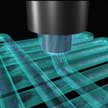 Biofabrication is a revolutionizing toolkit for regenerative medicine that allows cells and other biomaterials to be precisely combined and patterned into three-dimensional (3D) constructs through automated, cell-friendly fabrication methods. With rapid advanced in 3D-printing hardware on one hand and bioink materials on the other, biofabrication techniques have gained significant momentum and provide a powerful approach to tackle major hurdles in the generation of engineered living tissues. While 3D bioprinting is still in its early stages, the remarkable leap it has made in recent years points to the eventual reality of lab-grown, functional organs.
Biofabrication is a revolutionizing toolkit for regenerative medicine that allows cells and other biomaterials to be precisely combined and patterned into three-dimensional (3D) constructs through automated, cell-friendly fabrication methods. With rapid advanced in 3D-printing hardware on one hand and bioink materials on the other, biofabrication techniques have gained significant momentum and provide a powerful approach to tackle major hurdles in the generation of engineered living tissues. While 3D bioprinting is still in its early stages, the remarkable leap it has made in recent years points to the eventual reality of lab-grown, functional organs.
Mar 25th, 2020
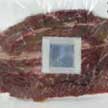 Researchers fabricated an innovative type of time-temperature sensor that can be used to detect and record temperature changes throughout the entire cold-supply chain. This nanofiber-based sensor only requires a single self-healing material with one phase, and functions as a result of its own intrinsic characteristics. Moreover, it is highly flexible, not at risk of chemical leakage, and cost-effective. Compared to electronic devices, the type of stimuli-responsive materials used in this device is cost-effective and simply to manufacture.
Researchers fabricated an innovative type of time-temperature sensor that can be used to detect and record temperature changes throughout the entire cold-supply chain. This nanofiber-based sensor only requires a single self-healing material with one phase, and functions as a result of its own intrinsic characteristics. Moreover, it is highly flexible, not at risk of chemical leakage, and cost-effective. Compared to electronic devices, the type of stimuli-responsive materials used in this device is cost-effective and simply to manufacture.
Mar 23rd, 2020
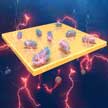 Researchers have identified the potential of using nanoscale carbon dots on bacteria for augmented bioelectricity production. They used this to demonstrate a novel method for significantly increasing the bacterial bioelectricity generation and applied it to set up microbial fuel cells. The results show that carbon dots' highly conductive carbon core not only improved overall systemic electrical conductivity but could also increase the packing density of the electron transfer path. This significantly improves the bioelectricity production of microbial fuel cells.
Researchers have identified the potential of using nanoscale carbon dots on bacteria for augmented bioelectricity production. They used this to demonstrate a novel method for significantly increasing the bacterial bioelectricity generation and applied it to set up microbial fuel cells. The results show that carbon dots' highly conductive carbon core not only improved overall systemic electrical conductivity but could also increase the packing density of the electron transfer path. This significantly improves the bioelectricity production of microbial fuel cells.
Mar 19th, 2020
 Recent developments in hydrogel chemistries, reinforcement approaches, and crosslinking methods have expanded the applications of 3D bioprinting to pharmaceutics, regenerative medicine, and biomedical devices. A multitude of 3D bioprinting techniques have been developed, but among these different approaches, extrusion-based 3D bioprinting has become a popular technique as it is easy to optimize and all its constituents are economical in price. A recent review elucidates the nuances of 3D bioprinting in a step-by-step guideline format, from its basics to more advanced levels.
Recent developments in hydrogel chemistries, reinforcement approaches, and crosslinking methods have expanded the applications of 3D bioprinting to pharmaceutics, regenerative medicine, and biomedical devices. A multitude of 3D bioprinting techniques have been developed, but among these different approaches, extrusion-based 3D bioprinting has become a popular technique as it is easy to optimize and all its constituents are economical in price. A recent review elucidates the nuances of 3D bioprinting in a step-by-step guideline format, from its basics to more advanced levels.
 Subscribe to our Nanotechnology Spotlight feed
Subscribe to our Nanotechnology Spotlight feed





